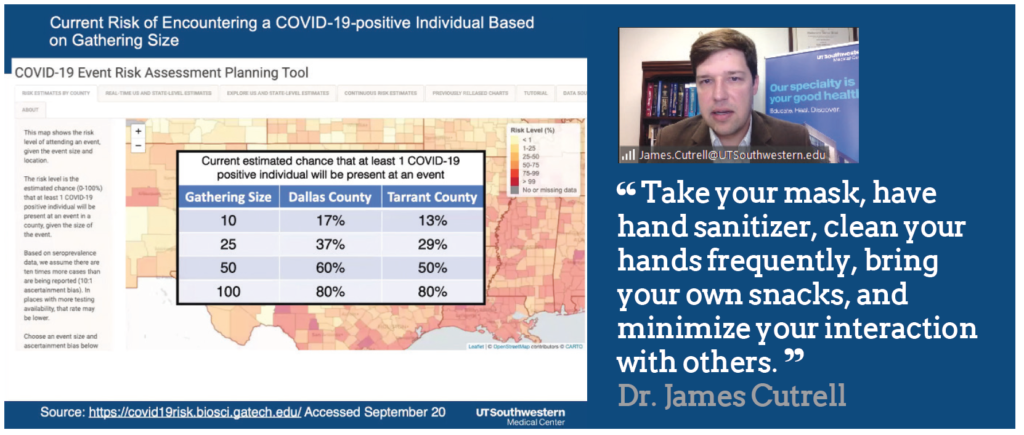COVID-19 a Once in a Generation-Type Pandemic
UT Southwestern infectious disease specialist hopeful about vaccine research
To assess health risks while attending a gathering in Dallas County, begin by counting the people in the room.
If there are 10 or fewer, the likelihood of one of them having COVID-19 is less than 20%.
But if there are 100 or more, that likelihood reaches 80%, according to data Dr. James Cutrell shared recently from a COVID-19 Event Risk Assessment Planning Tool developed by Georgia Tech University.
However, that’s not the whole story, the physician said. “Just because there is a COVID-infected person there, doesn’t mean everybody is going to be infected.”
Mask wearing and social distancing would still have the potential to prevent transmission, he explained.
Cutrell, program director of the Infectious Diseases Fellowship Program at UT Southwestern Medical Center, has talked about the novel coronavirus with journalists and others.
During a recent virtual presentation to the Preston Center Rotary Club, he described how the hospital responded when the virus arrived in the spring. Many employees began working remotely, and researchers pivoted to study the virus, focusing on prevention and treatments.

With more than 200,000 U.S. deaths so far – 1,000-plus in Dallas – Cutrell views this as a once in a generation-type pandemic.
Rotarians asked about risks associated with flying and the potential for a vaccine.
While increasingly data shows the precautions airlines have taken are making it safer to travel by plane, the doctor still sees it as a highly individualized personal decision.
Before boarding, travelers should consider whether they are high-risk for adverse outcomes from COVID-19 and whether the trip is necessary, he said.
“I think if it is essential travel, you can fly safely,” Cutrell said. “Take your mask, have hand sanitizer, clean your hands frequently, bring your own snacks, and minimize your interaction with others.”
As for vaccines, he knows of hundreds in preclinical studies and dozens in clinical trials. Of those, nine are in Phase III with thousands of volunteers from a broad spectrum of ages and demographics.
UT Southwestern could become a test site when Johnson and Johnson’s vaccine enters Phase III trials this fall, he said.
“I think there is some hope that maybe this fall before the end of the year for some of those vaccines in Phase III trials we may have data that would support an emergency authorization,” Cutrell said.
With a “normal disease,” the vaccine process could take two to five years to reach the general public. To trim that timeline, some of the top COVID-19 vaccine candidates have begun mass manufacturing to be ready if approved, he said.
But for that to happen, the data must show that one is both safe and effective, Cutrell said.
“If we have a really good vaccine, but we have a very low participation, it’s not going to be as effective,” he said. “The public needs to feel confident.”
Learn More: utsouthwestern.edu/covid-19/ | utswmed.org/medblog/topic/covid/ | covid19risk.biosci.gatech.edu

For nearly 40 years, People Newspapers has worked tirelessly to tell the stories—good, bad, and sublime—of our neighbors in the Park Cities and Preston Hollow. To support our efforts, please contact advertise@peoplenewspapers.com for advertising opportunities. Please also consider sharing this story with your friends and social media followers.









